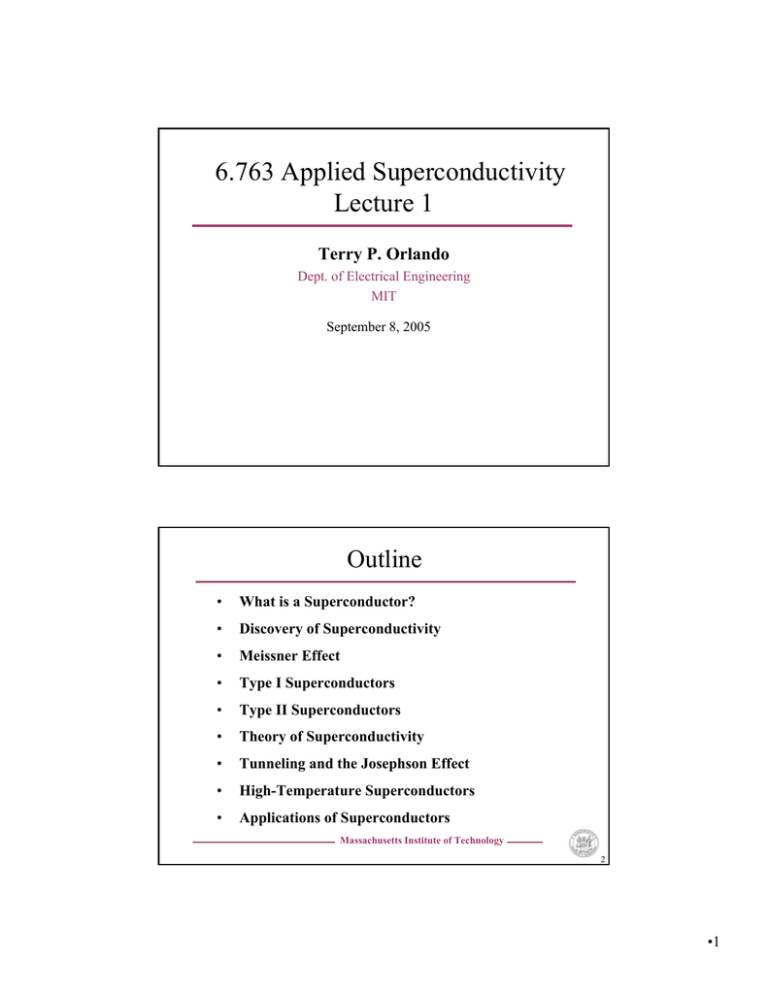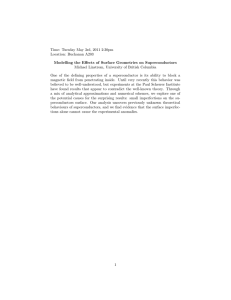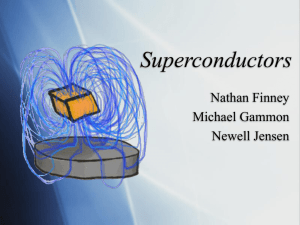Document 13510690
advertisement

6.763 Applied Superconductivity Lecture 1 Terry P. Orlando Dept. of Electrical Engineering MIT September 8, 2005 Outline • What is a Superconductor? • Discovery of Superconductivity • Meissner Effect • Type I Superconductors • Type II Superconductors • Theory of Superconductivity • Tunneling and the Josephson Effect • High-Temperature Superconductors • Applications of Superconductors Massachusetts Institute of Technology 2 •1 What is a Superconductor? “A Superconductor has ZERO electrical resistance BELOW a certain critical temperature. Once set in motion, a persistent electric current will flow in the superconducting loop FOREVER without any power loss.” Image removed for copyright reasons. Image removed for copyright reasons. Magnetic Flux explusion A Superconductor EXCLUDES any magnetic fields that come near it. Massachusetts Institute of Technology 3 How “Cool” are Superconductors? Below 77 Kelvin (-200 ºC): • Some Copper Oxide Ceramics superconduct Below 4 Kelvin (-270 ºC): • Some Pure Metals e.g. Lead, Mercury, Niobium superconduct Keeping at 77 K Keeping at 4K Keeping at 0 ºC Images removed for copyright reasons. Massachusetts Institute of Technology 4 •2 The Discovery of Superconductivity 1911 The Nobel Prize in Physics 1913 "for his investigations on the properties of matter at low temperatures which led, inter alia, to the production of liquid helium" Image removed for copyright reasons. Please see: _________________________________ http://nobelprize.org/physics/laureates/1913/onnes-lecture.pdf Image removed for copyright reasons. Please see: http://nobelprize.org/physics/laureates/1913/index.html Heike Kamerlingh Onnes the Netherlands Leiden University Leiden, the Netherlands b. 1853 d. 1926 •http://www.nobel.se/physics/laureates 5 Discovery of Superconductivity “As has been said, the experiment left no doubt that, as far as accuracy of measurement went, the resistance disappeared. At the same time, however, something unexpected occurred. The disappearance did not take place gradually but (compare Fig. 17) abruptly. From 1/500 the resistance at 4.2oK drop to a millionth part. At the lowest temperature, 1.5oK, it could be established that the resistance had become less than a thousand-millionth part of that at normal temperature. Image removed for copyright reasons. Please see: Figure 1.1, page 3, from Orlando, T., and K. Delin. Foundations of Applied Superconductivity. Reading, MA: Addison-Wesley, 1991. ISBN: 0201183234. Thus the mercury at 4.2oK has entered a new state, which, owing to its particular electrical properties, can be called the state of superconductivity.” Heike Kamerlingh Onnes, Nobel Lecture •http://www.nobel.se/physics/laureates 6 •3 Normal Metal vs Superconductor Image removed for copyright reasons. Please see: http://www.superconductors.org/Type1.htm 7 Periodic Table of Elements Image removed for copyright reasons. Please see: http://www.superconductors.org/Type1.htm •http://www.superconductors.org/Type1.htm 8 •4 A Superconductor is more than a perfect conductor, it is a Perfect Diamagnetism Images removed for copyright reasons. 9 Type-I Superconductor Images removed for copyright reasons. 10 •5 Type-II Superconductor Image removed for copyright reasons. Please see: "A current-carrying type II superconductor in the mixed state" from http://phys.kent.edu/pages/cep.htm http://phys.kent.edu/pages/cep.htm When a current is applied to a type II superconductor (blue rectangular box) in the mixed state, the magnetic vortices (blue cylinders) feel a force (Lorentz force) that pushes the vortices at right angles to the current flow. This movement dissipates energy and produces resistance [from D. J. Bishop et al., Scientific American, 48 (Feb. 1993)]. 11 Upper Critical Fields of Type II Superconductors Image removed for copyright reasons. 12 •6 BCS Theory of Superconductivity The Nobel Prize in Physics 1972 •“for their jointly developed theory of superconductivity, usually called the BCS-theory" Images removed for copyright reasons. Please see: http://nobelprize.org/physics/ laureates/1972/index.html John Bardeen Leon Neil Cooper 1/3 of the prize John Robert Schrieffer 1/3 of the prize 1/3 of the prize USA USA USA University of Illinois Urbana, IL, USA Brown University Providence, RI, USA University of Pennsylvania Philadelphia, PA, USA b. 1908 d. 1991 b. 1930 b. 1931 •http://www.nobel.se/physics/laureates ELECTRON-PHONON INTERACTIONS AND SUPERCONDUCTIVITY Nobel Lecture, December 11, 1972 By JOHN BARDEEN Departments of Physics and of Electrical Engineering University of Illinois Urbana, Illinois INTRODUCTION Our present understanding of superconductivity has arisen from a close interplay of theory and experiment. It would have been very difficult to have arrived at the theory by purely deductive reasoning from the basic equations of quantum mechanics. Even if someone had done so, no one would have believed that such remarkable properties would really occur in nature. But, as you well know, that is not the way it happened, a great deal had been learned about the experimental properties of superconductors and phenomenological equations had been given to describe many aspects before the microscopic theory was developed. 13 The Electron-phonon Interaction Image removed for copyright reasons. The origin of superconductivity in conventional superconductors http://www.physics.carleton.ca/courses/75.364/mp-2html/node16.html 14 •7 Cooper Pairs & Energy Gap Images removed for copyright reasons. Please see: Figure 5 and figure 6 from http://nobelprize.org/physics/ laureates/1972/cooper-lecture.html http://www.nobel.se/physics/laureates/1972/cooper-lecture.pdf 15 Superconducting Energy Gap Images removed for copyright reasons. Please see: Figure 1 and figure 2 from ___________________ http://nobelprize.org/physics/ ________________________ laureates/1972/bardeen-lecture.html http://www.nobel.se/physics/laureates/1972/bardeen-lecture.pdf 16 •8 The Nobel Prize in Physics 1973 "for their experimental discoveries regarding tunneling phenomena in semiconductors and superconductors, respectively" "for his theoretical predictions of the properties of a supercurrent through a tunnel barrier, in particular those phenomena which are generally known as the Josephson effects" Image removed for copyright reasons. Please see: Figure 1 from http://nobelprize.org/ physics/laureates/1973/giaever-lecture.html Images removed for copyright reasons. Please see: http://nobelprize.org/physics/laureates/1973/index.html Leo Esaki Ivar Giaever 1/4 of the prize 1/4 of the prize Brian David Josephson 1/2 of the prize Japan USA United Kingdom IBM Thomas J. Watson Research Center Yorktown Heights, NY, USA General Electric Company Schenectady, NY, USA University of Cambridge Cambridge, United Kingdom b. 1925 b. 1929 (in Bergen, Norway) b. 1940 •http://www.nobel.se/physics/laureates 17 Tunneling between a normal metal and another normal metal or a superconductor Images removed for copyright reasons. Please see: Figures 3 and 4 from http://nobelprize.org/physics/laureates/ 1973/giaever-lecture.html http://www.nobel.se/physics/laureates/1973/giaever-lecture.pdf 18 •9 Tunneling between two superconductors Giaever Tunneling Image removed for copyright reasons. Please see: Figure 10 from ______________ http://nobelprize.org/ _____________________________ physics/laureates/1973/giaever-lecture.html Josephson Tunneling 19 Josephson Junction Ψ1 = n1eiθ Superconductor Nb Ψ2 = n2 e 1 iθ Insulator ~10Å, Al2O3 2 • Josephson relations: • Behaves as a nonlinear inductor: I = I c sin ϕ V = LJ V= Φ 0 dϕ 2π dt ϕ = θ 2 − θ1 2π − Φ0 where 1 ∫ 2 r r A( r , t ) ⋅ d l LJ = dI , dt Φ0 2π I c cos ϕ Φ 0 = flux quantum 483.6 GHz / mV 20 •10 SQUID Magnetometers Φ0 I+ V+ 1pF Φ 1.1µm 1.1µm I- V20 µm DC SQUID Shunt capacitors ~ 1pF Jct. Size ~ 1.1µm Loop size ~20x20µm2 LSQUID ~ 50pH Ic~10 & 20µA 21 High-Temperature Superconductivity The Nobel Prize in Physics 1987 "for their important break-through in the discovery of superconductivity in ceramic materials" Images removed for copyright reasons. Please see: http://nobelprize.org/physics/ ____________________ laureates/1987/index.html __________________ J. Georg Bednorz 1/2 of the prize K. Alexander Müller 1/2 of the prize Federal Republic of Germany Switzerland IBM Zurich Research Laboratory Rüschlikon, Switzerland IBM Zurich Research Laboratory Rüschlikon, Switzerland b. 1950 b. 1927 Image removed for copyright reasons. Please see: Figure 1.5 from ______________ http://nobelprize.org/ ______________________________ physics/laureates/1987/bednorz-lecture.html •http://www.nobel.se/physics/laureates 22 •11 High-Temperature Superconductors Images removed for copyright reasons. Please see: Figures 1.13 and 1.14 from ____________________ http://nobelprize.org/physics/ laureates/1987/bednorz-lecture.html ________________________ http://www.nobel.se/physics/laureates/1987/bednorz-muller-lecture.pdf 23 Perovskite Structure Image removed for copyright reasons. Please see: Images from ______________________________________ http://cst-www.nrl.navy.mil/lattice/struk/perovskite.html •http://cst-www.nrl.navy.mil/lattice/struk/perovskite.html 24 •12 High-Temperature Superconductors Images removed for copyright reasons. 25 Uses for Superconductors • Magnetic Levitation allows trains to “float” on strong superconducting magnets (MAGLEV in Japan, 1997) Image removed for copyright reasons. Image removed for copyright reasons. • To generate Huge Magnetic field e.g. for Magnetic Resonance Imaging (MRI) • A SQUID (Superconducting Quantum Interference Device) is the most sensitive magnetometer. (sensitive to 100 billion times weaker than the Earth’s magnetic field) • Quantum Computing Massachusetts Institute of Technology Picture source: http://www.superconductors.org 26 •13 Large-Scale Applications Application Technical Points Power cables High current densities Current Limiters Uses highly nonlinear nature of transition Transformers High current densities and magnetic fields, has lower losses Motors/Generators Energy Storage Magnets Smaller weight and size, lower losses NMR magnets (MRI) Cavities for Accelerators Ultra high field stability, large air gaps Magnetic bearins Low losses, self-controlled levitation Need high fields and currents Smaller weight and size, lower losses High microwave powers Adapted from http://www.conectus.org/xxroadmap.html 27 Recent Advances in Superconductivity call for papers for 2006 MRS meeting High-temperature superconductors have been featured at MRS meetings since their discovery in 1986. Twenty years later, the progress both on the fundamental understanding of these materials and the path towards their industrial applications has been impressive. First-generation wires are now routinely produced in kilometer lengths and used in a variety of large-scale prototypes of practical devices, while the scale-up of second-generation wires (RE123-based coated conductors) for industrial manufacturing is progressing at a fast pace. These achievements have been made possible by cutting-edge developments in materials science and technology. Coated conductors are composites of nanoscale layers of various materials and functionalities; and the understanding of issues concerning textured templates, complex oxide epitaxy, interfacial reactions, metal-oxide interfaces, crystal chemistry, defect characterization, and diffusion barriers is essential for the optimization of their properties. A topic of present large interest is the improvement of the in-field critical current by introduction of appropriate vortex pinning centers. It is now clear that large improvements can be obtained through the nano-engineering of several types of defects. As the technology approaches maturity, new problems such as ac losses and thermal stabilization will become increasingly important. Superconducting MgB2 also attracts large interest due to its high-transition temperature (highest among binary compounds), chemical simplicity, low cost of the raw materials, and absence of weak-link limitations that allows the use of mature powder-in-tube technology to fabricate long wires. The inclusion of MgB2 presentations in the symposium will bring together both communities and will encourage the discussion of problems that are common to all superconducting wires. <http://www.mrs.org/meetings/spring2006/program/s06_cfp_hh.html> 28 •14 Phase Diagram of a Type II Superconductor Image removed for copyright reasons. Pleas see: Phase Diagram from http://www.futurescience.com/manual/sc1000.html#C •http://www.futurescience.com/manual/sc1000.html#C 29 Small-Scale Applications Application Technical Points Microwave filters in cellular stations Low losses, smaller size, sharp filtering Passive microwave devices, Resonators for oscillators Lower surface losses, high quality factors, small size Far-infrared bolometers nonlinear tunneling SIS curves, high sensitivity Microwave detectors Uses nonlinear tunneling SIS curves, high conversion efficiency for mixing X-ray detectors High photon energy resolution SQUID Magnetometers: Magneto-encephalography, NDT Ultra-high sensitivity to magnetic fields Voltage Standards Quantum precision Digital Circuits (SFQ) Up to 750 GHz, ultra-fast, low-power Adapted from http://www.conectus.org/xxroadmap.html 30 •15 Nanowire single-photon detector Image removed for copyright reasons. •K. Berggren, MIT Gol’tsman et al., APL, (2001). 31 Large-area single-photon detector Image removed for copyright reasons. •K. Berggren, MIT 32 •16 Economic Outlook Image removed for copyright reasons. Please see: Worldwide Markets for Superconductivity from http://www.superconductors.org/conectus.pdf _______________________________ •http://www.superconductors.org/conectus.pdf 33 The Promise of a Quantum Computer A Quantum Computer … • Offers exponential improvement in speed and memory over existing computers • Capable of reversible computation • e.g. Can factorize a 250-digit number in seconds while an ordinary computer will take 800 000 years! Current Research in my group focuses on Quantum Computation using Superconductors Massachusetts Institute of Technology 34 •17 The “Magic” of Quantum Mechanics States 0 and 1 are stored and processed AT THE SAME TIME Image removed for copyright reasons. Massachusetts Institute of Technology 35 The Superconducting “Quantum Bit” • An External Magnet can induce a current in a superconducting loop • The induced current can be in the opposite direction if we carefully choose a different magnetic field this time Image removed for copyright reasons. • To store and process information as a computer bit, we assign: as state | 0 ⟩ clockwise as state | 1 ⟩ Anti-clockwise 36 •18 Persistent Current Qubit • Depending on the direction of the current, state |0⟩ will add a and state |1⟩ different magnetic field to the external magnet Image removed for copyright reasons. • This difference is very small but can be distinguished by the extremely sensitive SQUID sensor Massachusetts Institute of Technology 37 Macroscopic Quantum Model Our Approach to Superconductivity ssi Cla cal Superconductor as a perfect conductor & perfect diamagnet Macroscopic Quantum Model Ψ(r) Supercurrent Equation Js(r) Type II Superconductivity Josephson Equations Large-Scale Applications Small-Scale Applications Ginzburg-Landau Ψ(r) = | Ψ(r)|2 e iθ(r,t) Microscopic Quantum BCS 38 •19



